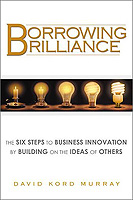
|
 |
Borrowing Brilliance: The Six Steps to Business Innovation by Building on the Ideas of Others David Kord Murray 
Format: Hardcover, 304pp. ISBN: 9781592404780 Publisher: Gotham Pub. Date: September 17, 2009 Average Customer Review: For Bulk Orders Call: 626-441-2024 Description and Reviews From The Publisher: In a book poised to become the bible of innovation, a renowned creativity expert reveals the key to the creative process—“borrowing.” The goal of Borrowing Brilliance, Dave Murray says, is to take the creative process out of the shadows of the subconscious mind and bring it into the conscious world. It’s to dispel the misconceptions about creativity, lift the fog off its true nature, and reveal the fact that brilliance is borrowed. In order to create, first you have to copy. Once understood, you can still use your subconscious as a partner in the process, he says, but you’ll learn how to take control over it and not sit there waiting for that elusive idea to pop into your mind. Instead, he’ll teach you how to go out and find the material for ideas and then how to take this stuff and reconfigure it into a new solution. It’s not magical, he says, it only appears that way. If you want to perform the trick then you’d better learn how it works. Borrowing Brilliance is a six-step process, and so this book is organized into six chapters. Dave thinks of the first three steps in terms of a construction metaphor. An idea is like a house or a building. Your business problem is the foundation of that house. In other words, you build your idea on a foundation of well-defined problems. Once defined, you borrow ideas from places with a comparable problem. You start close to home by borrowing from your competitors, then you venture farther by borrowing from other industries, and finally you travel outside of business and look for ideas with that problem in the scientific, entertainment, or artistic worlds. Then, you take these borrowed ideas and start combining them to form the overall structure of your house, to form the structure of your new solution. Dave will teach you how to use metaphors and analogies to create this structure and so create the overall form of your new idea. He calls the first three steps as The Origin of a Creative Idea: Step One: Defining—Define the problem you’re trying to solve. Step Two: Borrowing—Borrow ideas from places with a similar problem. Step Three: Combining—Connect and combine these borrowed ideas. However, Dave says, the construction metaphor only extends so far. Creating a new idea requires a process of trial and error, something an engineer or architect would never suggest doing in the construction of a building. So, I think of the next three steps using an evolutionary metaphor. An idea forms over time the way an organic species forms. An idea is a living thing, a descendent of the thing it derived from, the way a simple cart evolved into a chariot, the chariot into a horse drawn carriage, and the carriage into the automobile. Ideas give birth to one another. Using this metaphor, your subconscious mind becomes the womb in which new ideas are created. You’ll learn how to give birth to them by teaching your subconscious to define, borrow, and combine and so you will need to feed it with problems, borrowed ideas, and metaphorical combinations. Then you’ll incubate it and let your subconscious form a more coherent solution. He’ll teach you to use your judgment of this new solution as the mechanism by which to drive the evolution of the idea, in the same way that the fight for survival drives the evolution of organic species. Then you’ll separate these judgments into positive and negative, thus revealing the strengths and weaknesses of your new solution. You’ll use these judgments to improve the idea by eliminating its weaknesses and enhancing its strengths. In other words, you’ll create the way the Renaissance masters did, through the incremental improvement of existing ideas. Over time, though, your new idea will grow and evolve, and when you present it to the world it will appear to be completely new and original and the incremental steps will merely be fossils in the process. Dave calls these steps The Evolution of a Creative Idea: Step Four: Incubating—Allow the combinations to incubate into a solution. Step Five: Judging—Identify the strength and weakness of the solution. Step Six: Enhancing—Eliminate weak points while enhancing strong ones. The sixth step isn’t really a step at all, it’s a return to the previous five steps: defining; borrowing; combining; incubating; and judging; all in an attempt to advance your idea through elimination and enhancement. While the first five steps are linear and build off each other, the sixth step is more of a haphazard one. It’s more organic, a self-organizing process, one in which the process creates itself and is unique to each project. After passing judgment, you’ll return to the problem, reconsider it, perhaps redefine it or decide to solve a completely different one. Your positive/negative judgments will develop your creative intuition and give you greater insight into what to borrow and where. You’ll replace ill-fitting components with new ones that work better. This will help you to restructure your idea and thus make new combinations that work better to solve your problem. You’ll simulate the mind of a genius by using left-brain thinking to take your idea apart, reconfigure it, and then use right-brained thinking to put it back together. In between these steps, you’ll re-incubate, returning to the well of subconscious thought as the process evolves. The order in which you do these things will depend upon your unique situation. Since Dave’s not a college professor or academic researcher, this book will not read like a textbook. Instead, he’ll use stories to explain his thesis. He’ll show you how the Google guys defined their problems which led to their innovative ideas. How Bill Gates borrowed the ideas of others and created the most powerful company in the world and became known as one of the pirates of Silicon Valley. Then he’ll show how Charles Darwin did the same thing but why he isn’t called the pirate of Edinburgh Valley. He’ll explain how to use metaphors to make combinations, to fuse things together, and create the overall structure of your idea by showing you how George Lucas did this very thing to create his lucrative movie franchise and once you understand, Dave will show you how to apply this technique in a practical way in your business. Then he’ll tell you the story of Steve Jobs and how he uses his contrasting personality traits to pass judgment on ideas and in the process develop a highly sensitive form of creative intuition. Finally, he’ll lead you on this road of discovery by telling you his own story. When you’re done, you’ll agree that brilliance is actually borrowed, easily within your reach, for, really, it’s knowing where to borrow the materials from and how to put them together that determines your creative ability. Sadly, Dave says he’ll never be Steve Jobs, and neither will you, but he can simulate the way he thinks even if it isn’t inherent in him. And you can too. Each chapter features real-life examples of brilliant borrowers, including profiles of Larry Page and Sergey Brin (the Google guys), Bill Gates, George Lucas, Steve Jobs, Albert Einstein, and other creative thinkers. Murray used these methods to re-create his own career and he shows how you can harness them to find your own creative solutions. First you copy, then you create. And the further from your own company you look, the more creative the solution. Reviews A wonderfully enjoyable tour of the creative process. Murray's lively description of how he used these tools to create his own products is a major plus. People will be stealing from this work for years to come! —Roger von Oech author, "A Whack on the Side of the Head" and the "Creative Whack Pack." Everything a business book should be. A great concept brilliantly expressed in an interesting and well-written book. —Al Ries author, "Positioning" and "War in the Boardroom" We met in strange places: Lake Tahoe, San Diego, Milwaukee, Kansas City. And so I spent my years with David Murray, just as zany, articulate, well-read, and completely unpredictable as is his book. Ah, the book: Dave Murray in person is just like his book, only more so. “Break the rules,” he said. We broke them. “I’m thinking of writing a book about this,” he said. I encouraged him. And here it is, how to be brilliant and innovative. New ideas are always amalgamations of old ones. Borrowed. Murray makes it seem simple, but don’t be deceived. Everything he says is true. All the principles are there: simply stated, simple to understand. —Don Norman author, "The Design of Everyday Things" Borrowing Brilliance is truly creative brilliance! It is simple, easy to read…it’s magical. David Murray shared his life’s personal stories juxtaposed with his six simple steps to business innovation. His book brings to life these steps through building on the ideas of others. You can borrow and use his six steps and explode with fresh new ideas the day after finishing Borrowing Brilliance. —Jack Mitchell author, "Hug Your Customers and Hug Your People" and CEO of Mitchell's It’s the best book ever written. —Nancy Murray the author’s mom If I ever read a book. This will be the one. —Paris Hilton, heiress
About the Author David Kord Murray began his career as an aerospace engineer working on the conceptual development team for the International Space Station. He has also been an entrepreneur, inventor, and Fortune 500 executive. He was the head of innovation for the software company Intuit and held similar positions at other Fortune 500 companies. Find Items On Similar Subjects |
|

The Essential Lists BOOKS TO READ BEFORE YOU LEAD 
Grow Your Leadership Skills NEW AND UPCOMING LEADERSHIP BOOKS 
Classic Leadership Books BOOKS TO READ BEFORE YOU LEAD |
 |
| ||
 | © 2019 LeadershipNow™ All materials contained in https://www.LeadershipNow.com are protected by copyright and trademark laws and may not be used for any purpose whatsoever other than private, non-commercial viewing purposes. Derivative works and other unauthorized copying or use of stills, video footage, text or graphics is expressly prohibited. |
||